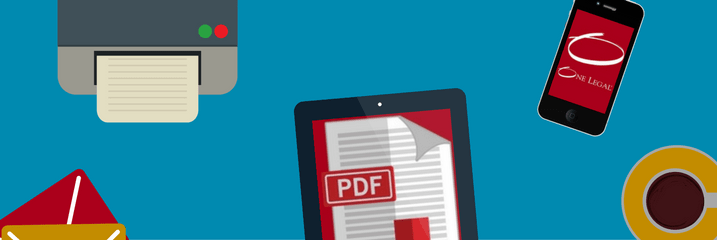If you don’t know your EFMs from your EFSPs, talk of “the cloud” leaves you wondering if people are discussing the weather, or “phishing” seems like something one ought to do with a rod and reel then this post is for you!
It’s true that technology can sometimes appear to be advancing so fast that it often feels like we’re developing a whole language to describe it. However, now that tech competence is required for U.S. legal professionals, it’s important to understand what it’s all about.
To help you out, we’ve put together a glossary of 27 of the most common technology terms every legal professional should know and that will come up when you’re at work and thinking about the future tech requirements for your office. Check it out below.
A | B | C | D | E | F | G | H | I | J | K | L | M | N | O | P | Q | R | S | T | U | V | W | X | Y | Z
A
Adobe Acrobat
Adobe Acrobat is the market-leading software application for viewing, creating, manipulating, and managing documents in Portable Document Format (PDF – see below). There are different versions available, depending on your needs. Acrobat Reader is the basic free version that only supports the viewing, printing, and annotating of PDFs. If you need to perform more complex work, like adding bookmarks, adding/removing pages, signing, and editing PDFs, then you’ll need to investigate the paid-for professional version.
Antivirus software
It’s a dangerous online world out there, and basic internet security starts with antivirus software. Originally, antivirus software was designed just to detect and remove computer viruses. These days, it typically does that in addition to protecting against other online threats that put your data at risk. The ABA recommends investing in a well-regarded paid-for application, such as AVG.
B
Backup
Here in California, you don’t need to think very long to come up with a scenario where remote backup might be a good idea. If an earthquake made your office and computers unusable or inaccessible, what would you do? That’s where backup systems (offsite storage of digital files, folders) come into play. You should consider setting up a tool like CrashPlan that, once subscribed, will automatically store all of your data in a secure, offsite, server.
C
Cloud storage
“The cloud” refers to remote servers that host, or store, your information. Many law firms use cloud storage to enable them to access information from anywhere they have an internet connection. Check out this recent post for a summary of some popular cloud storage tools.
Cloud-based software
Today, many popular pieces of software are based in the cloud rather than being installed locally on your own servers or computer. This has a number of advantages, in addition to lawyers no longer requiring their own servers. For one, responsibility for maintenance and staying up to date falls on the software provider rather than the user. There’s more info over on the “Lawyerist” blog.
Cybersecurity
Often confused with anti-virus measures, cybersecurity refers to the broader set of processes and protocols that ought to be in place to protect against Internet-based security threats. These might include, for instance, implementing two-step authentication for access to sensitive files, implementing a password policy, or encrypting email communications. Above the Law has a useful seven-step summary for those getting started.
D
Document assembly
Document assembly software automates the creation of legal documents are used time and time again, including wills, leases, contracts, and so on. The Solo and Small Firm Legal Tech Guide says “you can think of document assembly as templates that can be used over and over.”
Disaster recovery
Disaster recovery isn’t a piece of technology, but rather the set of processes you’ll need in place to get your technology up and running again in the event of a disaster (think massive power outage, fire, natural disaster, etc.). Things to consider include, whether systems are available remotely and whether client information and case files are securely backed-up.
Digital signature
A digital signature can, in many jurisdictions and circumstances, replace a “wet” ink signature. Digital signatures differ from electronic signatures. The latter are merely electronic representations of a signature (e.g. an image). The former are secure, unique, and verifiable marks that indicate that can authenticate documents, usually contracts.
Digital dictation
A way to record and edit the spoken word in real-time via devices such as digital voice recorders or speech recognition software. There are a range of devices out there: check out this summary on “Law Technology Today” for an overview.
E
eDiscovery
Discovery in legal proceedings such as litigation, where the information sought is in an electronic format (often referred to by the acronym ESI, or electronically stored information). Knowing what sort of ESI might be relevant and the steps involved in obtaining it is increasingly considered to be a key legal skill.
eFiling
Electronic filing (eFiling), is the process of uploading documents and digitally delivering court filings to a court’s computer system via a secure file transfer. Because of the obvious time saving and reduced administrative cost (no more queueing and handing papers over at the court window!) more and more courts are establishing eFiling systems.
EFM
The electronic filing manager (or EFM) is the intermediate system that accepts filings from the various EFSPs and distributes them to the appropriate courthouse for the clerks to view. Once a clerk has reviewed and accepted the filing, it enters the court’s case management system (CMS).
EFSP
An electronic filing service provider (EFSP) is the vendor that provides the online portal via which attorneys and other filers can submit their documents to a court. In most jurisdictions, filers choose an EFSP, such as One Legal, to submit documents.
eService
Electronic service is the sharing of subsequent litigation documents between the parties via electronic means (as opposed to mail or hand-delivery). It can be as simple as using email to share documents, but most law firms choose a secure eService platform (such as One Legal) that hosts files and sends traceable notifications to recipients. Learn more about eService >>
Extensible Markup Language (XML)
You may hear this phrase occasionally, especially in relation to eFiling, so it is worth defining. When documents are converted to digital files they must be coded in a way that is both human and machine-readable — that’s XML. I.e. it ensures that the information you provide in an eFiling is correctly displayed to the clerks receiving it.
Encryption
Encryption is a way of protecting digitally stored data from malicious hackers. In an encryption scheme, information written in plain text is scrambled into gibberish. This gibberish can only be de-encrypted by those with the correct technology installed so that if someone steals your client files, for instance, it’s tough for them to make sense of them.
M
Matter management software
Matter management (you likely call it case management if you’re in a civil law firm) refers to the activities involved in managing all aspects of a legal issue (a “matter”). These tools will typically allow for accurately tracking cases through their various stages, from initiation through to billing.
Metadata
Specifically, you should be aware of metadata in the context of word processing where it means all of the information contained within a file that isn’t visible on the page. This includes boring stuff: the author, date of creation, etc. But it also includes everything ever typed into that document — including all revisions and any comments ever added. Often, that’s stuff you’ll want to remove. Fortunately, doing so is a piece of cake!
Multifunctional device
An example of a simple concept hidden behind techie jargon. It is what it says: a device that can perform multiple functions. It almost always refers to those large scanner, copier, printer machines, however.
O
OCR
Optical character recognition is the electronic conversion of images of typed, handwritten, or printed text into machine-encoded text that can be searched and edited as though it had been typed electronically. Typically, you’ll want to apply OCR to scanned court filings — a simple process with Adobe Acrobat.
P
Phishing
In computer security, phishing refers to the act of sending out malicious and unsolicited emails that masquerade as official and legitimate emails, thus luring the recipient into taking inappropriate actions, such as handing over usernames, passwords, or credit card information.
Paperless law office
More realistically, a reduced paper office. The paperless office is a term used to describe firms that have implemented processes to reduce the need to print paper copies. There are big advantages in terms of time, cost reduction, and productivity to be had. Learn more about the benefits of going paperless >>
The portable document format (or PDF) is a popular file format that provides an electronic image of text or graphics that looks like a printed document. It is the most stable document format, meaning that once saved PDFs can be opened on almost all computers and will retain their originally intended appearance. Learn how to create “court-friendly” PDFs when filing >>
Practice management software
Typically cloud-based pieces of software that provide a range of tools essential to the smooth-running of a legal practice. Most will include some of the following features: case/matter management, contact/client information management, time and bill tracking, and calendaring/scheduling. The best will also include features such as secure client portals for sharing documents and case updates. The ABA has produced a handy comparison chart.
V
Virtual law firm
A virtual law firm is a legal practice that operates without a brick-and-mortar office. Only really made possible by recent advances in high-speed internet technology and cloud-based software, some lawyers can now practice from anywhere with electricity and a web connection.
W
Workflow
Very generally, a workflow is the sequence of steps one must go through to complete an action. You’ll likely come across the term in the context of electronic court filing since one must work through several steps (many court-mandated) to provide all of the necessary information.







